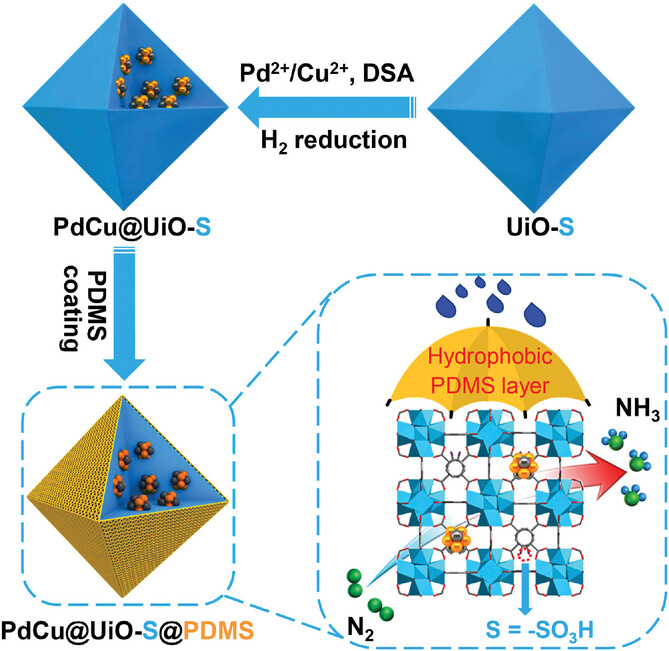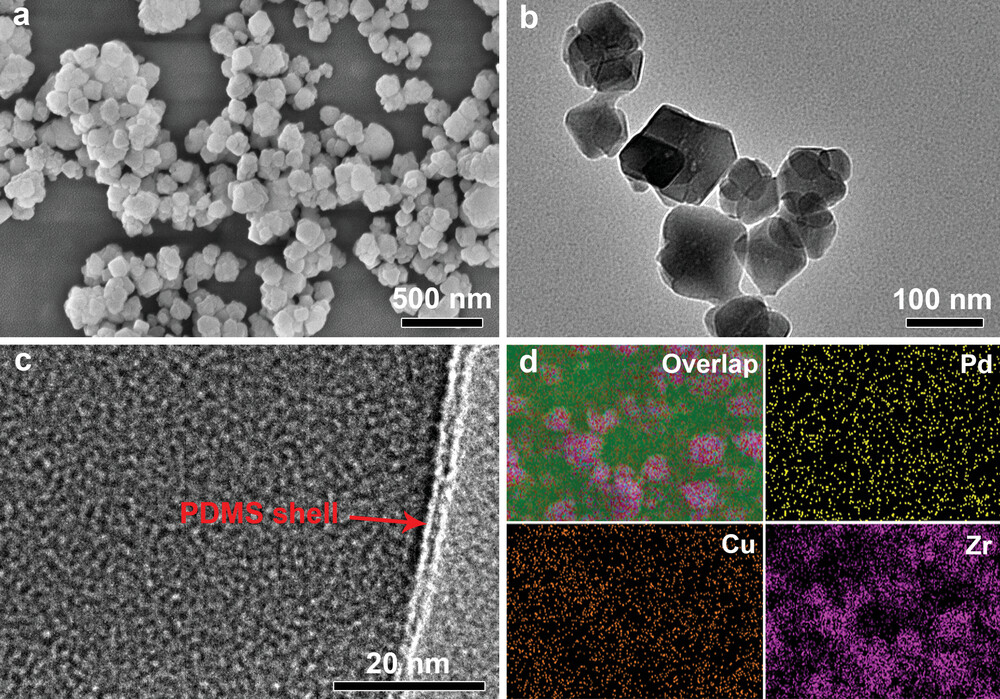Home >
News > Electronic State and Microenvironment Modulation of Metal Nanoparticles Stabilized by MOFs for Boosting Electrocatalytic Nitrogen Reduction
Electronic State and Microenvironment Modulation of Metal Nanoparticles Stabilized by MOFs for Boosting Electrocatalytic Nitrogen Reduction
Summary:
The authors from University of Science and Technology of China, North China Electric Power University, and Southeast University developed PdCu@UiO-S@PDMS material with electron-rich PdCu nanoparticles, protonated -SO₃H groups, and hydrophobic PDMS layer, achieving a Faraday efficiency of 13.16% and an NH₃ yield of 20.24 μg h⁻¹ mgcat.⁻¹ in the application of electrocatalytic nitrogen reduction (NRR) field.

Background:
1. To address the issues of high energy consumption in industrial Haber-Bosch ammonia synthesis and low Faraday efficiency (FE) of electrochemical NRR due to competitive hydrogen evolution reaction (HER), previous researchers used metal nanoparticles (e.g., Pd NPs) and MOF/COF materials, but Pd was prone to hydrogen poisoning and balancing proton supply with HER inhibition was difficult.
2. The authors in this study proposed encapsulating PdCu NPs in sulfonate-functionalized UiO-S and coating PDMS, obtaining a catalyst with excellent NRR performance.
Research Content:
1.Synthesis:
The authors synthesized UiO-S via solvothermal method, prepared PdCu@UiO-S by double-solvent approach (DSA) and H₂ reduction, and obtained PdCu@UiO-S@PDMS through PDMS vapor deposition.
2.Characterizations:
1) BET: UiO-S (927 m²/g), PdCu@UiO-S (836 m²/g), PdCu@UiO-S@PDMS (807 m²/g); no pore size distribution data provided.
2) SEM/TEM tests show the particle size of PdCu@UiO-S@PDMS is ~120 nm, with a ~1 nm PDMS coating.
3) Electrochemical tests: LSV shows higher current in N₂; EIS shows small charge transfer resistance; double-layer capacitance of PdCu@UiO-S@PDMS is 13.5 mF/cm².
3.Application:
The material was tested in electrocatalytic NRR: at -0.25 V vs. RHE, FE=13.16%, NH₃ yield=20.24 μg h⁻¹ mgcat.⁻¹; 5 cycles and 20 h tests show good stability.
4.Mechanism:
Experiment analysis: XPS/CO-DRIFT confirm electron-rich Pd; in-situ FT-IR shows enhanced NH₃ signal. DFT: PdCu@UiO-S@PDMS has lower N₂H* formation energy barrier (0.40 eV vs. 1.16 eV), upshifted Pd d-band center strengthens Pd-N interaction.

Outlook:
This research successfully prepared a high-performance NRR catalyst by synergistic modulation of electronic state and microenvironment, providing a strategy for MOF-based catalyst design and promoting green ammonia synthesis.
Electronic State and Microenvironment Modulation of Metal Nanoparticles Stabilized by MOFs for Boosting Electrocatalytic Nitrogen Reduction
Authors: Lulu Wen, Kang Sun, Xiaoshuo Liu, Weijie Yang, Luyan Li, Hai-Long Jiang*
DOI: 10.1002/adma.202210669
Link: https://onlinelibrary.wiley.com/doi/10.1002/adma.202210669
The above review is for academic progress sharing. For any errors or copyright issues, please contact us for correction or removal.

